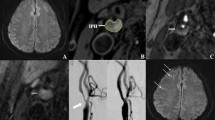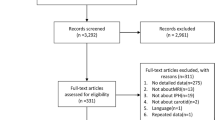Abstract
Intraplaque hemorrhage (IPH), a component of late-stage complicated plaque, identified within carotid endarterectomy surgical specimens has been recently demonstrated to predict cardiovascular (CV) events. MRI is able to depict carotid IPH. We investigated the ability of carotid MR-depicted IPH (MR-IPH) to identify high-risk CV patients. From January 2008 to April 2011, 216 patients (mean age, 67.5 years; range 31–100) referred for neurovascular MRI at an academic tertiary care centre, underwent 3T carotid MRI with adjunct 3D high-spatial-resolution coronal imaging to detect MR-IPH. Five experienced neuroradiologists made a binary decision on the presence or absence of MR-IPH. Patients’ charts were reviewed blindly for demographic and CV outcomes data. Of the patients with and without MR-IPH, 62.5 % (15/24) and 19.8 % (38/192) had a composite CV event (defined as a past myocardial infarction, coronary intervention (i.e., angioplasty, stenting or bypass graft) and/or peripheral vascular disease), respectively. The odds ratio (OR) of a composite CV event in the MR-IPH group was 6.75 (Bivariable analysis, 95 % CI 2.75–16.6, p < 0.0001) and 3.25 (Multivariable regression analysis, 1.14–9.37, p = 0.028). MR-IPH had the highest OR of a prior CV event compared to other variables including age, sex, hypertension and stenosis. The OR of individual CV events was also significant: MI (3.35, 95 % CI 2.11–14.2, p < 0.01), coronary stenting (26.4, 95 % CI 8.80–79.4, p < 0.01), coronary angioplasty (21, 95 % CI 4.84–91.1, p < 0.01), and PVD (3.35, 95 % CI 1.09–10.3, p < 0.05). MR-IPH is independently associated with prior CV events in patients who are evaluated for neurovascular disease. Carotid MR-IPH, employed easily in routine clinical practice, is emerging as an indicator of systemic vascular disease and may potentially be a useful surrogate marker of CV risk including in those already undergoing neurovascular imaging.


Similar content being viewed by others
References
Moody A (2012) Stroke: cause and effect–seek and ye shall find. J Am Coll Cardiol Imaging 5(4):406–408
Freilinger TM, Schindler A, Schmidt C, Grimm J, Cyran C, Schwarz F, Bamberg F, Linn J, Reiser M, Yuan C, Nikolaou K, Dichgans M, Saam T (2012) Prevalence of nonstenosing, complicated atherosclerotic plaques in cryptogenic stroke. J Am Coll Cardiol Imaging 5(4):397–405
Lindsay AC, Biasiolli L, Lee JM, Kylintireas I, MacIntosh BJ, Watt H, Jezzard P, Robson MD, Neubauer S, Handa A, Kennedy J, Choudhury RP (2012) Plaque features associated with increased cerebral infarction after minor stroke and TIA: a prospective, case-control, 3-T carotid artery MR imaging study. J Am Coll Cardiol Imaging 5(4):388–396
Underhill HR, Yuan C, Yarnykh VL, Chu B, Oikawa M, Polissar NL, Schwartz SM, Jarvik GP, Hatsukami TS (2009) Arterial remodeling in subclinical carotid artery disease. J Am Coll Cardiol Imaging 2(12):1381–1389
Hellings WE, Peeters W, Moll FL, Piers SR, van Setten J, Van der Spek PJ, de Vries JP, Seldenrijk KA, De Bruin PC, Vink A, Velema E, de Kleijn DP, Pasterkamp G (2010) Composition of carotid atherosclerotic plaque is associated with cardiovascular outcome: a prognostic study. Circulation 121:1941–1950
Noguchi T, Yamada N, Higashi M, Goto Y, Naito H (2011) High-intensity signals in carotid plaques on T1-weighted magnetic resonance imaging predict coronary events in patients with coronary artery disease. J Am Coll Cardiol 58:416–422
Steg PG, Bhatt DL, Wilson PW, D’Agostino R Sr, Ohman EM, Röther J, Liau CS, Hirsch AT, Mas JL, Ikeda Y, Pencina MJ, Goto S, REACH Registry Investigators (2007) One-year cardiovascular event rates in outpatients with atherothrombosis. JAMA 297:1197–1206
Raman SV, Winner MW 3rd, Tran T, Velayutham M, Simonetti OP, Baker PB, Olesik J, McCarthy B, Ferketich AK, Zweier JL (2008) In vivo atherosclerotic plaque characterization using magnetic susceptibility distinguishes symptom-producing plaques. J Am Coll Cardiol Imaging 1(1):49–57
Singh N, Moody AR, Gladstone DJ, Leung G, Ravikumar R, Zhan J, Maggisano R (2009) Moderate carotid artery stenosis: MR imaging-depicted intraplaque hemorrhage predicts risk of cerebrovascular ischemic events in asymptomatic men. Radiology 252:502–508
Moody AR, Murphy RE, Morgan PS, Martel AL, Delay GS, Allder S, MacSweeney ST, Tennant WG, Gladman J, Lowe J, Hunt BJ (2003) Characterization of complicated carotid plaque with magnetic resonance direct thrombus imaging in patients with cerebral ischemia. Circulation 107:3047–3052
Eng J (2003) Sample size estimation: how many individuals should be studied? Radiology 227:309–313
Bitar R, Moody AR, Leung G, Symons S, Crisp S, Butany J, Rowsell C, Kiss A, Nelson A, Maggisano R (2008) In vivo 3D high-spatial-resolution MR imaging of intraplaque hemorrhage. Radiology 249:259–267
Kerwin WS, Liu F, Yarnykh V, Underhill H, Oikawa M, Yu W, Hatsukami TS, Yuan C (2008) Signal features of the atherosclerotic plaque at 3.0 Tesla versus 1.5 Tesla: impact on automatic classification. J Magn Reson Imaging 28:987–995
Underhill HR, Yarnykh VL, Hatsukami TS, Wang J, Balu N, Hayes CE, Oikawa M, Yu W, Xu D, Chu B, Wyman BT, Polissar NL, Yuan C (2008) Carotid plaque morphology and composition: initial comparison between 1.5- and 3.0-T magnetic field strengths. Radiology 248:550–560
Saam T, Hatsukami TS, Yarnykh VL, Hayes CE, Underhill H, Chu B, Takaya N, Cai J, Kerwin WS, Xu D, Polissar NL, Neradilek B, Hamar WK, Maki J, Shaw DW, Buck RJ, Wyman B, Yuan C (2007) Reader and platform reproducibility for quantitative assessment of carotid atherosclerotic plaque using 1.5T Siemens, Philips, and General Electric scanners. J Magn Reson Imaging 26:344–352
Zhao Q, Zhao X, Cai Z, Li F, Yuan C, Cai J (2011) Correlation of coronary plaque phenotype and carotid atherosclerotic plaque composition. Am J Med Sci 342:480–485
Zhao X, Underhill HR, Zhao Q, Cai J, Li F, Oikawa M, Dong L, Ota H, Hatsukami TS, Chu B, Yuan C (2011) Discriminating carotid atherosclerotic lesion severity by luminal stenosis and plaque burden: a comparison utilizing high-resolution magnetic resonance imaging at 3.0 Tesla. Stroke 42:347–353
Cheung HM, Moody AR, Singh N, Bitar R, Zhan J, Leung G (2011) Late stage complicated atheroma in low-grade stenotic carotid disease: MR imaging depiction–prevalence and risk factors. Radiology 260:841–847
Yoshida K, Sadamasa N, Narumi O, Chin M, Yamagata S, Miyamoto S (2011) Symptomatic low-grade carotid stenosis with intraplaque hemorrhage and expansive arterial remodeling is associated with a high relapse rate refractory to medical treatment. Neurosurgery 70:1143–1151
Kurosaki Y, Yoshida K, Endo H, Chin M, Yamagata S (2011) Association between carotid atherosclerosis plaque with high signal intensity on T1-weighted imaging and subsequent ipsilateral ischemic events. Neurosurgery 68:62–67
Altaf N, Daniels L, Morgan PS, Auer D, MacSweeney ST, Moody AR, Gladman JR (2008) Detection of intraplaque hemorrhage by magnetic resonance imaging in symptomatic patients with mild to moderate carotid stenosis predicts recurrent neurological events. J Vasc Surg 47:337–342
Altaf N, Beech A, Goode SD, Gladman JR, Moody AR, Auer DP, MacSweeney ST (2007) Carotid intraplaque hemorrhage detected by magnetic resonance imaging predicts embolization during carotid endarterectomy. J Vasc Surg 46:31–36
Yamada N, Higashi M, Otsubo R, Sakuma T, Oyama N, Tanaka R, Iihara K, Naritomi H, Minematsu K, Naito H (2007) Association between signal hyperintensity on T1-weighted MR imaging of carotid plaques and ipsilateral ischemic events. AJNR Am J Neuroradiol 28:287–292
Takaya N, Yuan C, Chu B, Saam T, Underhill H, Cai J, Tran N, Polissar NL, Isaac C, Ferguson MS, Garden GA, Cramer SC, Maravilla KR, Hashimoto B, Hatsukami TS (2006) Association between carotid plaque characteristics and subsequent ischemic neurovascular events: a prospective assessment with MRI: initial results. Stroke 37:818–823
Jansen CH, Perera D, Makowski MR, Wiethoff AJ, Phinikaridou A, Razavi RM, Marber MS, Greil GF, Nagel E, Maintz D, Redwood S, Botnar RM (2011) Detection of intracoronary thrombus by magnetic resonance imaging in patients with acute myocardial infarction. Circulation 124:416–424
Acknowledgments
NS/ARM are supported by the Canadian Institute of Health Research (CIHR), Radiology Society of North America (RSNA) R&E Foundation and Physicians’ Services Incorporated Foundation, and University of Toronto Collaborative Cardiovascular Sciences Program.
Conflict of interest
No conflicts of interest are declared.
Author information
Authors and Affiliations
Corresponding author
Rights and permissions
About this article
Cite this article
Singh, N., Moody, A.R., Rochon-Terry, G. et al. Identifying a high risk cardiovascular phenotype by carotid MRI-depicted intraplaque hemorrhage. Int J Cardiovasc Imaging 29, 1477–1483 (2013). https://doi.org/10.1007/s10554-013-0229-3
Received:
Accepted:
Published:
Issue Date:
DOI: https://doi.org/10.1007/s10554-013-0229-3




